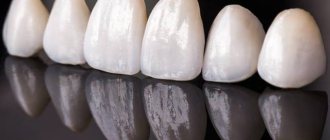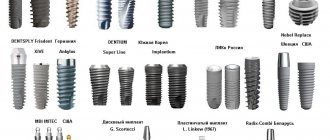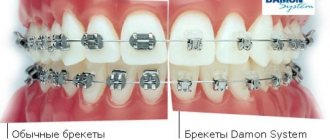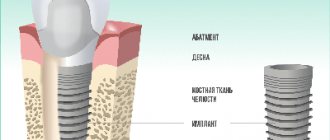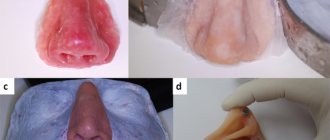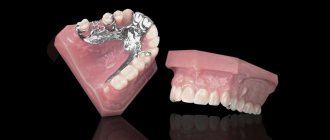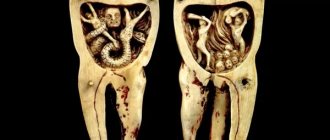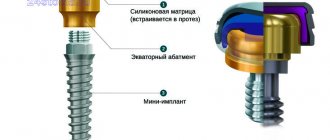1964
To fix the prosthesis in the mouth, preventing it from moving, clasps are used in orthopedics.
With their help, pressure is redistributed during the act of chewing. At the same time, they cover the dental unit only 2/3 of its circumference, creating support and ensuring retention of the prosthesis.
What is a clasp?
A clasp is one of the parts of a removable denture that is responsible for fixing (fastening, holding, whatever you want) the denture in the mouth. This is its main function. I'll tell you about others below.
(The picture shows a prosthesis with clasps)
The clasp can be obtained in 2 ways:
- Or cast - often together with the rest of the prosthesis frame
- Or bend it out of wire
The method depends on the type of prosthesis and, accordingly, on the type of clasp. Since it is customary to use certain clasps in certain prostheses:
- – plate prosthesis – retaining clasp – arching method
- — clasp prosthesis — support-retaining clasp — casting method
Pros and cons of nylon
There are also nylon - one-piece dentures with clasps for attaching to abutment teeth
The main positive quality of nylon is the ability to create any shade, so it is easy for the dentist to choose the color of the base. Clasps for nylon dentures are poured simultaneously with the base, so they merge and do not stand out when you smile. The thin layer of plastic is not felt when chewing and talking.
But some patients are dissatisfied with nylon prostheses with clasps:
- atrophy of gum tissue and its subsidence are possible;
- dentures deteriorate faster and become deformed;
- sometimes there is pain when biting and chewing;
- you have to visit the dentist more often for correction;
- the likelihood of developing infections, stomatitis, and gingivitis increases.
More modern versions of Acry-free from an Israeli manufacturer are manufactured using software and scanning of the oral cavity. They are distinguished by high aesthetics, perfectly follow the contours of the gums, therefore they are invisible and practical. Suitable for full or partial dentures, replacement of dentures with metal clasps.
What types of clasps are there?
There are 3 types in total, of which 2 main ones:
- holding;
- support-holding
(3rd type - support clasp, used as an auxiliary clasp together with the support-retaining one)
(The figure shows an example of a support clasp)
Retaining clasps are needed only to hold the denture in the mouth. They are used in plate prostheses.
Support-retaining clasps, unlike support clasps, transfer part of the chewing load to the tooth.
A prosthesis with this type of clasp is called semi-physiological . Such dentures are more comfortable and easier to get used to. (Read more in our article)
A little history of creation
The need to develop the theory of clasps arose due to the wide variety of clinical situations and frequent breakdowns of simple wire clamps. Orthopedics needed standard solutions that would make it easier for orthopedists and dental technicians to select the optimal clasp design for a specific clinical situation.
In 1956, in Frankfurt am Main, Ney's company united the efforts of craftsmen of various specializations - dentists, metallurgists, engineers versed in theoretical mechanics - to develop a line of cast clasps for clasp dentures.
Actually, there was no particular need to develop new designs. It was necessary to analyze and select the best designs that existed at that time.
As a result, a system of clasps was created, named after the company that performed this work (Neya). It included five types of fixators, the design of which best satisfied the requirements for them and covered almost all clinical situations.
What does a clasp consist of?
Let's start with retention clasp, as it is simpler. It has 3 parts:
- 1 – shoulder – holds the clasp on the tooth
- 2 - body - connects the shoulder and process
- 3 - process - holds the clasp inside the prosthesis
support-retaining is more complex .
We will analyze it using the example of the classic Acker clasp (1st clasp of the Ney system) in which the following parts are distinguished
- shoulder;
- occlusal pad;
- clasp body;
- clasp extension.
The shoulder is the part of the clasp that holds the clasp on the tooth.
The occlusal pad (foot) is the third short arm of a triangular (oval) clasp. It lies on the occlusal surface of the tooth and is needed to transfer the chewing load to the tooth.
The body of the clasp is the junction of all its elements.
The clasp extension (connecting rod) is the rod with which the clasp is connected to the prosthesis. The length and shape of the process depends on the type of connection between the prosthesis and the clasp.
Anchor design
The popularity of the products is due to their design features. The mechanism is equipped with a rigid anchor of increased rigidity, which prevents movement of the prosthesis.
Characteristics:
- perpendicular placement of the onlay relative to the dental axis while simultaneously tilting the coronal area;
- the shoulder includes three elements (support - serves to stabilize the orthodontic apparatus; fixing part in the soft tissue area - provides elasticity; intermediate element - provides a clasp connection of medium rigidity).
It is used to eliminate defects accompanied by approximately equal separation of the outer and inner surfaces of the tooth. Due to the lack of springiness, the system is designed to be fixed exclusively between the chewing area and the dividing line.
Disadvantages of the Anker system:
- covering the dental unit with the shoulder, which increases the likelihood of accumulation of food debris;
- restrictions (the system is intended for molars only).
Clasp functions
Each clasp must provide 4 main functions : support, retention, coverage and counteraction.
- Support - the clasp rests on the tooth and transfers part of the chewing pressure to it
- Retention - the clasp prevents the denture from falling off the tooth or falling off while eating.
- Coverage - the clasp prevents the lateral displacement of the prosthesis.
- Counteraction - 2 shoulders clamp the tooth, while each shoulder prevents movement in its direction
- Clasp system Ney
Now Ladies and Gentlemen, we will present to your attention a brief description of each of the 5 types of clasps of the Ney system.
Background of creation
In 1949 of the last century, American researchers (dentists, mathematicians and metallurgists) developed and implemented the Ney system. The principle of the new system was the use of clasps made by casting, which load the tooth only in the axial direction.
This technique has become a breakthrough in prosthetics, since when installing clasps there is no need to wear crowns, and its use is possible for any condition of the teeth.
In addition, the newest procedure turned out to be safe for the patient, since it does not cause traumatic damage to the surface enamel.
Ney clasp system:
- Type 1 - Acker clasp;
- Type 2 - Roach double-sided T-clasp;
- Type 3 - combined clasp (Acker-Roach);
- Type 4 - rear (reverse) action clasp;
- Type 5 - ring clasp..
(Figure 5 types of clasps)
Acker's clasp (Ney I).
The Acker clasp consists of an occlusal pad, a body and two arms. In this case, the onlay is located on the occlusal surface of the tooth.
Usage: The most common type of clasp, used in standard situations (when the clasp line divides the tooth roughly)
Roach's Clammer (Ney II)
The clasp consists of 2 T-shaped arms, an occlusal pad, a body and a process
: Used for high clasp lines and deep undercuts. They are also more emthetic because their shoulders are closer to the gums.
Clasp with Acker and Roach shoulders (Ney III).
A combined clasp consists of a rigid arm with an occlusal pad (like an Acker clasp) and a T-shaped arm of a Roach clasp.
Use : The clasp is used on premolars, molars and canines at different levels of the clasp line on the tooth surfaces.
The Roach shoulder, as you remember, is used for large undercut depths.
Reverse action clasp (Ney IV)
It consists of one almost circular arm on which the occlusal pad is located.
Use : It is used more often on the premolars of the lower jaw with the end defect of the dentition.
This is interesting! This clasp is called so because under chewing load the tooth tilts not in the direction of the defect, but back , towards the neighboring tooth. This fact prevents the tooth from tipping over and as a result the tooth is not injured.
Ring clasp (Ney V)
The clasp consists of one (two) occlusal pads, a long arm that almost completely surrounds the tooth, a body and a process.
Usage : Ring clasp is used on single standing molars
Conclusion : I hope you were interested in learning what a clasp is and why it is needed. And also about 5 types of Ney clasp system. These concepts come up more than once in the work of a dentist and understanding them is very important.
I really hope that I have helped you at least a little on your difficult life path. Read other articles, develop, learn new things. Good luck!
conclusions
Despite the fact that Ney clasps were developed in the middle of the last century, their use is still relevant today.
The simplicity of the design ensures high practicality, wear resistance, and, importantly, after installation a high degree of aesthetic value is noted.
In addition, to minimize the occurrence of breakage, areas located closer to the base are made thicker and more durable, and distant sections tend to gradually thin out, taking on the shape of the oral cavity.
If you find an error, please select a piece of text and press Ctrl+Enter.
Tags: removable dentures
Did you like the article? stay tuned
Previous article
Aquasplint is an innovative method of treating and diagnosing TMJ abnormalities
Next article
How to effectively and quickly remove plaque?
Manufacturing Basics
Clasps are made by technologists who focus on the prosthesis that will be installed on the patient. The manufacturing technology goes through the following sequence of actions:
- the clasp is essentially a hook that secures the prosthesis, so it is given the desired shape using specialized forceps, round nose pliers or pliers;
- first, a shoulder is formed that covers the dental crown;
- then the body itself is formed.
Dental technicians make the necessary bends to form clasps quickly and accurately, in just a few bends.
Features of the production of the shoulder and contact process
The desired shape of the clasp is formed using round nose pliers. The contact process and the shoulder are formed as separate elements using different tools.
The contact process is first formed with pliers and then flattened on an anvil. This procedure is necessary to apply special notches that promote tight bonding of the process to the base.
A number of rules apply to the manufacture of a shoulder:
- the shoulder must have a sufficient level of elasticity, which is more typical of wire elements than cast ones;
- the shoulder is designed in such a way that its parts lie between the gum and the equator;
- when fixed to an abutment tooth, the material should not cause discomfort;
- the element must adhere to the tooth surface at all points of contact in order to prevent excessive pressure and thinning of the enamel;
- After rounding the shoulder, it must be thoroughly polished to avoid possible trauma to the mucous systems.
The video shows the manufacturing process of Jackson clasps.
Side effects from clasps
Denture clasps can cause:
- To the abrasion of the tooth enamel itself due to constant load and micro-movements.
- This leads to a significant deterioration in the hygienic condition of the mouth due to the fact that the clasp is a separate structure and various food debris can accumulate under it. As a result, carious processes begin to develop very quickly. And this destroys the supporting teeth.
- Clasps can cause teeth to become very loose. This happens due to the movements of the prosthesis in a horizontal position. As a result, there is a functional overload of the teeth, which serve as support.
Sources:
- https://youstom.com/protezirovanie/klammer.html
- https://www.vash-dentist.ru/protezirovanie/semnyie-p/klammerov-sistemyi-neya.html
- https://zubovv.ru/protezirovanie/semnyie-p/sovremennyie-vidyi-klammerov.html
- https://CreateSmile.ru/klammer/
- https://dentaclass.ru/protezirovanie/klassifikaciya-klammerov.html
- https://my-ort.ru/novosti/klammery-neya/
- https://zubovv.ru/protezirovanie/semnyie-p/klammeryi-sistemyi-neya.html
Manufacturing
There are several ways to make clasps. Plastic products are usually made by injection molding. First, the product is shaped using wax, then it is replaced with the base material. Stamped models are produced by stamping from metal alloys. Bent systems are made using tongs. The technician may also use pliers or needle nose pliers. With their help, the master gives the wire the desired shape.
Stages of making a clasp using the bent method:
- using pliers, one end of the wire is bent to create the shoulder of the product;
- a second bend of the wire is performed to form the body;
- the wire is bent a third time to form an appendage.
Location requirements
Often, the service life of a prosthesis depends on how successfully the clasps are installed during prosthetics:
- The success of the process depends on the anatomical shape of the natural teeth.
The correct shape guarantees good stability. However, installation is also possible in the presence of small defects, which the doctor eliminates before prosthetics. Units with a low conical crown or a heavily exposed neck can be corrected. - The stability of natural teeth is the key to good installation of the structure.
Movable units do not allow the material to be successfully fixed, but the doctor can identify the cause and select the necessary treatment. In addition, sanitation of the oral cavity immediately before prosthetics is mandatory. Caries and minor inflammations also need to be treated. Only after this should we talk about the possibility of installing a prosthesis. - The correct bite is of great importance, including the correct relationship of the supporting tooth with the antagonists. With a very tight closure, even a small overlay can disrupt the bite, since it is placed in the fissure and disrupts the natural anatomical pattern.
If the jaw arches close too tightly, the specialist installs a protective crown on the supporting tooth. If the clinical situation does not allow the use of such material, then another tooth is selected for support.
